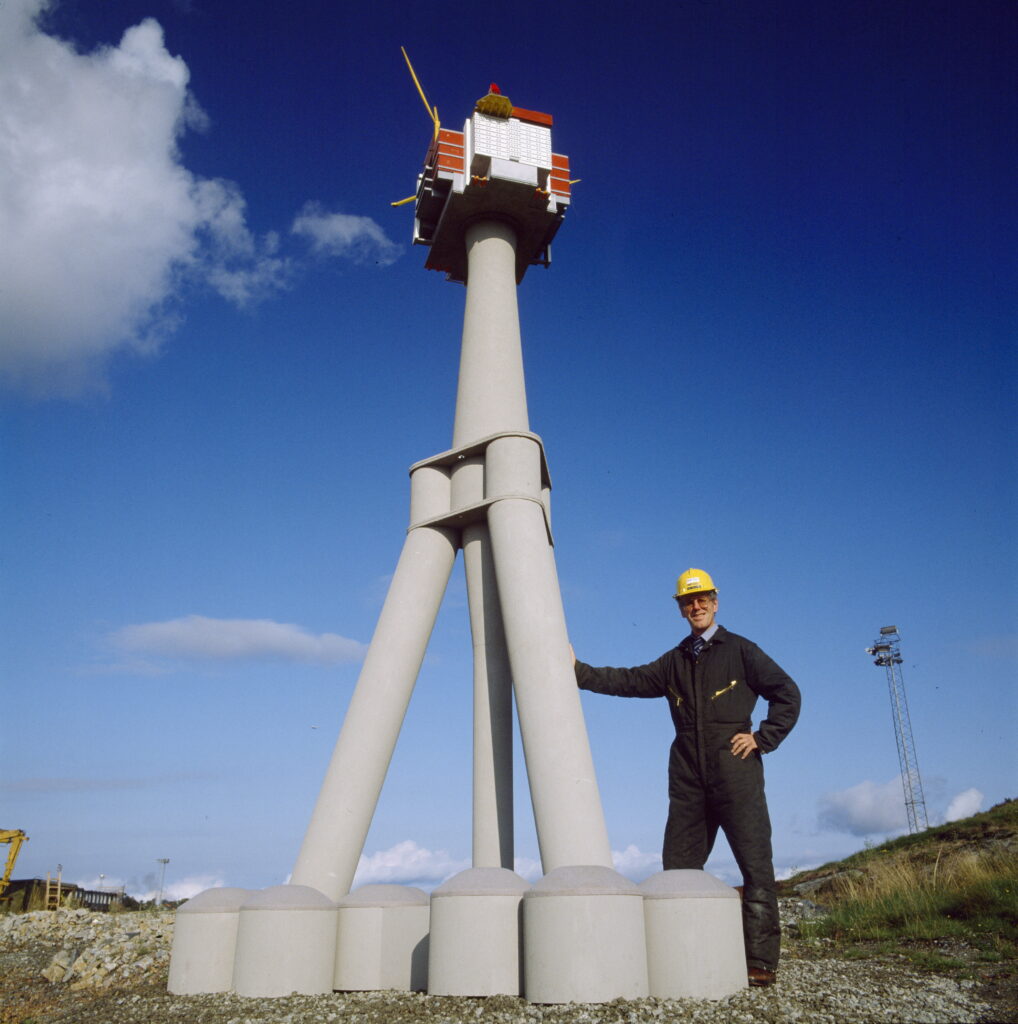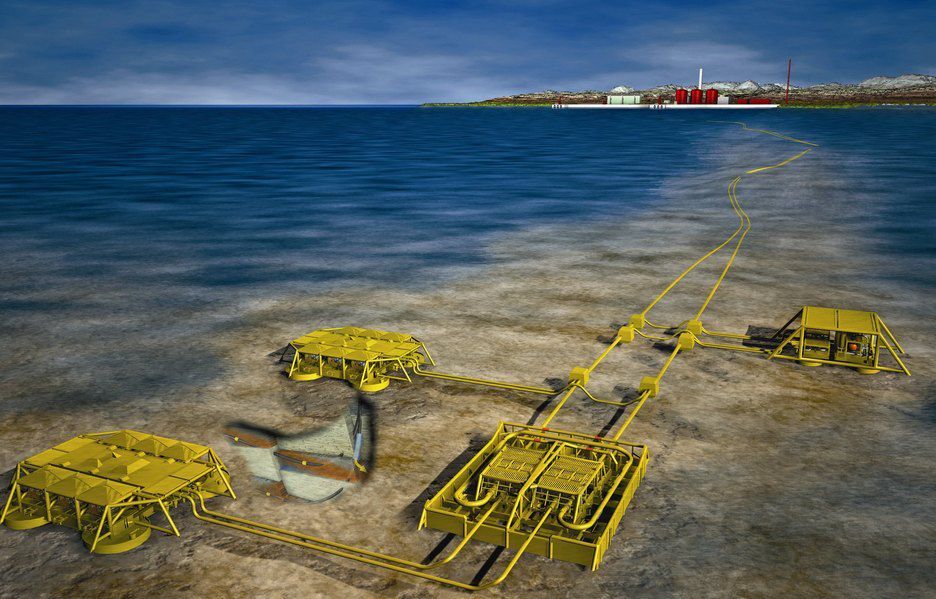Snøhvit – the “invisible” gas field

Opening Norway’s Barents Sea sector for oil exploration in 1979 reflected a desire to promote industrial development in the far north. Exploration soon yielded results, with Ross Rig making Askeladd the first discovery for Statoil. Such an early success was fabulous, which is why it was named after a character in Norway’s folk tales who constantly finds things. Nevertheless, the discovery did not generate big headlines – it was far too early to decide if it was commercial.[REMOVE]Fotnote: Status, no 13, 1981, “Spor av gass på Tromsøflaket”.
Albatross was proven nearby the following year. Hopes grew in northern Norway for much-needed industrial activity and jobs. But after Statoil CEO Arve Johnsen had given a speech in Tromsø in August 1982, local newspaper Nordlys noted with disappointment that the company was unable to promise any special treatment of north Norwegian industry in the event of a development.[REMOVE]Fotnote: Nordlys, 31 August 1982. “Ingen fordeler for næringslivet i nord”.
Seeking a profitable project

The first development plan for Askeladd/Albatross was presented in 1984, and proposed a concrete tripod standing in 300 metres of water. But this type of gravity base structure (GBS) was expensive, and both processing the gas offshore and piping it ashore would be complicated. Questions included who would buy the gas, and how it was to be brought to market. Statoil and its partners did not take long to realise that the project would be unprofitable and to shelve it.[REMOVE]Fotnote: Askeladd. En vurdering av muligheter for en lønnsom utvinning og avsetning av naturgass fra Nord-Norge, 1984.
Statoil made another large gas discovery not far from Askeladd and Albatross on 12 September 1984, and optimism spread once again. Containing both gas and oil, this find was named Snøhvit (Snow White) in good fairy-tale tradition. It extended across three licences, operated by Statoil, Norsk Hydro and France’s Total operator respectively.
Driven by a strong desire to be the first with an oil development off northern Norway, Statoil took fresh heart. The other licensees preferred to bide their time, since large gas deposits further south on the Norwegian continental shelf (NCS) were better placed geographically for export to continental Europe and the UK. But Statoil, with Johnsen in the van, nevertheless refused to give up and launched a new planning round.[REMOVE]Fotnote: Jacobsen, Alf R, 2010, Snøhvit. Historien om olje og gass i Barentshavet: 103.
In 1987-88, the company proposed an option based on two semi-submersible platforms. Total was involved in these plans, since it had entered into a collaboration with Statoil on Snøhvit and gas liquefaction in northern Norway. However, the 1986 oil price slump hampered further progress with the project. Securing the long-term contracts for liquefied natural gas (LNG) essential to realising it provide impossible. The proposals were shelved once again.[REMOVE]Fotnote: Ibid: 158-161.
Moreover, Hydro drew up plans for the licence it operated in the area based on the concept of a pure subsea development. The company had come to believe in such approaches after implementing the Troll-Oseberg gas injection (Togi) project in the North Sea during 1990. That had yielded experience with using seabed installations to supply gas for injection in another reservoir. Full of self-confidence, Hydro maintained that utilising subsea facilities remotely controlled from land would halve the cost of bringing Snøhvit on stream. This was a very forward-looking approach, but was it feasible?
Petroleum and energy minister Eivind Reiten and his civil servants viewed Hydro’s project with interest and launched a consultation.[REMOVE]Fotnote: Nordlys, 20 June 1990, “Snøhvit”. “Landing oil and gas often attracts gas-based industrial activity,” Reiten observed in 1990. “That could in turn mean valuable jobs for people in Finnmark.”[REMOVE]Fotnote: Dagens Næringsliv, 27 June 1990, “Snøhvit i drift innen ti år.” Hydro wanted the operator role for the production facilities and pipeline if its “Togi solution” was chosen. The proposal took Statoil very much by surprise.
Expectations in northern Norway rose yet again. The challenge was still finding a market for the gas. Statoil negotiated on this with US and Italian companies in 1990, but these efforts proved fruitless and the development plans were put on ice in 1992.
Subsea the solution
Encouraged by positive measures and reliefs for the petroleum industry from the Labour government under Gro Harlem Brundtland, Statoil dusted off its Snøhvit plans yet again in 1995-96.[REMOVE]Fotnote: Dagens Næringsliv, 19 September 1996, “Statoil vil blåse liv i Snøhvit”. Attention concentrated for several reasons on a subsea solution. Platforms cost more to build and operate than seabed wells. The Barents Sea climate, with winter storms and ice formation, also posed a risk for platform, equipment and personnel.

Statoil was the driving force, and allied itself with Linde, a German refrigeration specialist and engineering company. This collaboration yielded the idea of building a gas liquefaction plant on a barge at a reasonably priced yard abroad, which could be towed to Melkøya island off Hammerfest in northern Norway and plugged into the rest of the facility.

However, relations between Statoil, Hydro and Total were prickly. Many difficulties arose. Total, which ranked as the world’s most experienced LNG developer, considered itself the obvious choice to manage construction of the onshore facilities. Statoil could then handle the field installations and pipelines to land.[REMOVE]Fotnote: Dagens Næringsliv, 3 December 2005, “Koste hva det koste vil”. For its part, the latter wanted to use a Snøhvit development to build up experience which put it in a position to participate in projects – particularly the huge Shtokman discovery – in the Russian sector of the Barents Sea.
Hydro reacted negatively to Statoil’s wilfulness. It also wanted a role in the project, and launched an offensive towards the government in 1998 to exploit the thin oil zone in the field – as the company had done with success on Troll. However, Hydro failed to win support for this.[REMOVE]Fotnote: Aftenposten, 31 July 2001, “Schjøtt-Pedersen kan vekke liv i Snøhvit”.
Statoil’s solution for producing the gas won the day. In October 2000, executive vice president Henrik Carlsen presented a preliminary final report which recommended development at a cost of NOK 39.5 billion. Statoil chair Ole Lund, who was born and raised in Hammerfest, supported the plan.[REMOVE]Fotnote: Henrik Carlsen in conversation with Arnfinn Nergaard and Kristin Øye Gjerde, 27 January 2017.
The subsea solution incorporated a set of overtrawlable installations on the seabed, remote control via fibreoptic cable, and multiphase flow transport to land. In addition to zero harmful discharges to the sea, the gas liquefaction plant would return 700 000 tonnes of CO2 per annum from the wellstream to the field area for injection into a sub-surface formation.[REMOVE]Fotnote: www.statoil.com/content/dam/statoil/documents/impact-assessment/Statoil-Konsekvensutredning%20Sn%C3%B8hvit%20LNG%20april%202001.pdf But would the project be profitable?
Since Snøhvit was to be operated from land and developed with seabed installations, one question was which part of the scheme would be subject to offshore tax at 78 per cent and which would pay the onshore rate of 28 per cent. The finance ministry, with Finnmark native Karl-Eirik Schjøtt-Pedersen as minister, provided a clarification in July 2001 which yielded NOK 500 million in tax reliefs for the project. That was nevertheless insufficient for Statoil and its partners.[REMOVE]Fotnote: Aftenposten, 31 July 2001, op.cit. Yet again, they shelved the scheme and refrained from submitting a plan for development and operation (PDO) of the field.
That prompted full political mobilisation in Finnmark, with Hammerfest mayor Alf E Jakobsen in the lead. He called Labour prime minister Jens Stoltenberg personally – even though it was in the middle of the summer holidays – and requested a meeting.[REMOVE]Fotnote: Alf R Jacobsen, 2010, Snøhvit. Historien om olje og gass i Barentshavet: 229-232. Two decades of waiting for the opening of the northern petroleum province was more than enough. When the gas had even found a buyer, solution must be devised which made it possible to realise the project. With the aid of a tax approach which regarded Snøhvit as a single unit with a 78 per cent tax rate and shortened depreciation time for the field from six to three years, it proved possible to cut expenses by NOK 1 billion. That helped. The formal PDO was submitted to the petroleum and energy ministry the same autumn and was nodded through – with the tax rebate – by the Storting (parliament) on 7 March 2002.[REMOVE]Fotnote: Dagens Næringsliv, 3 December 2005, “Koste hva det koste vil”.
Subsea wells direct to land
Five years later, the installations were ready to come on stream. First gas from Snøhvit entered the Melkøya plant at 02.00 on 21 August 2007, and regular operation began on 13 September.
This development was a pioneering project in every respect. It was the first field on the NCS to be remotely operated from land, utilising fibreoptic cables. Doing this over 143 kilometres was groundbreaking, and called for much testing in advance.[REMOVE]Fotnote: Asle Solheim in conversation with Arnfinn Nergaard and Kristin Øye Gjerde, 20 January 2017. Control room operators at Melkøya had an overview of activity in the production facilities on the seabed, the pipelines and the onshore plant. These systems were monitored with the aid of data presented across a 12-metre-wide wall of monitors.
The three discoveries covered by the unitised field were developed in phases so they did not all come on stream at the same time.[REMOVE]Fotnote: https://www.regjeringen.no/no/dokumenter/stprp-nr-35-2001-2002-/id205915/sec2?q=br%C3%B8nn. Both Snøhvit and Askeladd featured three subsea templates with eight well slots apiece. At a later stage, Albatross was developed with a five-slot template. In addition to the producers, one well was drilled for CO2 injection.[REMOVE]Fotnote: Henrik Carlsen in conversation with Arnfinn Nergaard and Kristin Øye Gjerde, 27 January 2017.
Downhole pressure drives production to land. At 143 kilometres, the main pipeline is the world’s longest for an unprocessed wellstream. This comprises a mix of natural gas, natural gas liquids (NGL), condensate and water as well as monoethylene glycol (MEG). The last of these is added at the wellhead as an “antifreeze” to prevent the formation of gas hydrates (a form of hydrocarbon ice which can create lumps or plugs). These could cause a production shutdown or damage the pipelines and receiving equipment.

The most complex part of the facilities is the receiving and processing plant at Melkøya. Condensate is first separated out and stabilised before transfer to tanks for export. The MEG is also removed for reuse. Water and CO2 are removed as well. The remaining hydrocarbons enter the liquefaction stage.
At the core of the Melkøya facility is the seawater-cooled refrigeration plant, based on technology developed jointly by Statoil and Linde.[REMOVE]Fotnote: Teknisk Ukeblad, 7 November 2011, “Snøhvit er en suksess”. Natural gas is cooled down to -163°C, when it becomes LNG. This comprises about 90 per cent methane, with nitrogen, ethane and propane accounting for the remainder. After intermediate storage provided by two big tanks, the LNG is loaded into specialised carriers for shipment to market.[REMOVE]Fotnote: https://www.regjeringen.no/no/dokumenter/stprp-nr-35-2001-2002-/id205915/sec2?q=br%C3%B8nn.
Like other Statoil projects, Snøhvit and Melkøya failed to come in on budget. As noted above, the estimated cost when development began was NOK 39.5 billion. The final bill came to NOK 58.3 billion. The liquefaction plant experienced a long and difficult start-up, with a number of shutdowns and extensive repair work. Despite that, no heads rolled in Statoil. The overruns occurred when oil prices were good and made them easier to accept.
arrow_backUnplumbed depths in IndonesiaTurmoil and tenacity in Libyaarrow_forward